University Research Design: Analyzing Diversity and Leadership Styles
VerifiedAdded on 2020/05/16
|8
|1457
|104
Report
AI Summary
This report presents a hypothetical research design comparing qualitative and quantitative methodologies for studying workplace diversity and leadership. The qualitative design employs focus group interviews and personal interviews to explore the impact of diversity and effective leadership styles. Data analysis involves thematic framework analysis, including coding and interpretation to identify patterns. The quantitative design aims to identify the most suitable leadership style for managing a diversified workforce, utilizing survey methods and questionnaires for data collection. Statistical analysis, including regression and hypothesis verification, is employed to analyze the collected data. The report concludes by highlighting the distinct approaches and outcomes of each research method, emphasizing their respective strengths in addressing the complexities of diversity and leadership in the workplace. The report offers valuable insights for students seeking to understand the nuances of research design in the context of organizational studies.
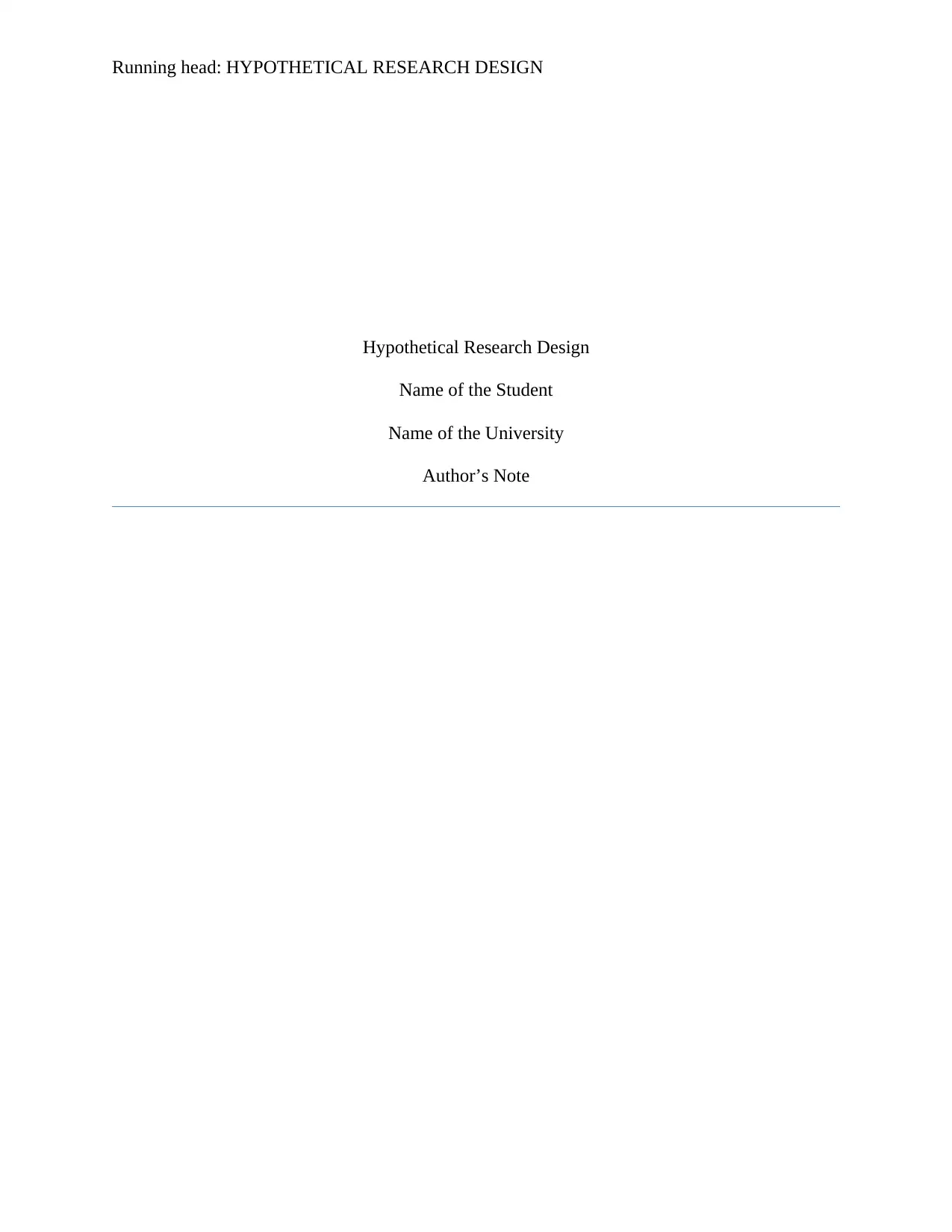
Running head: HYPOTHETICAL RESEARCH DESIGN
Hypothetical Research Design
Name of the Student
Name of the University
Author’s Note
Hypothetical Research Design
Name of the Student
Name of the University
Author’s Note
Paraphrase This Document
Need a fresh take? Get an instant paraphrase of this document with our AI Paraphraser
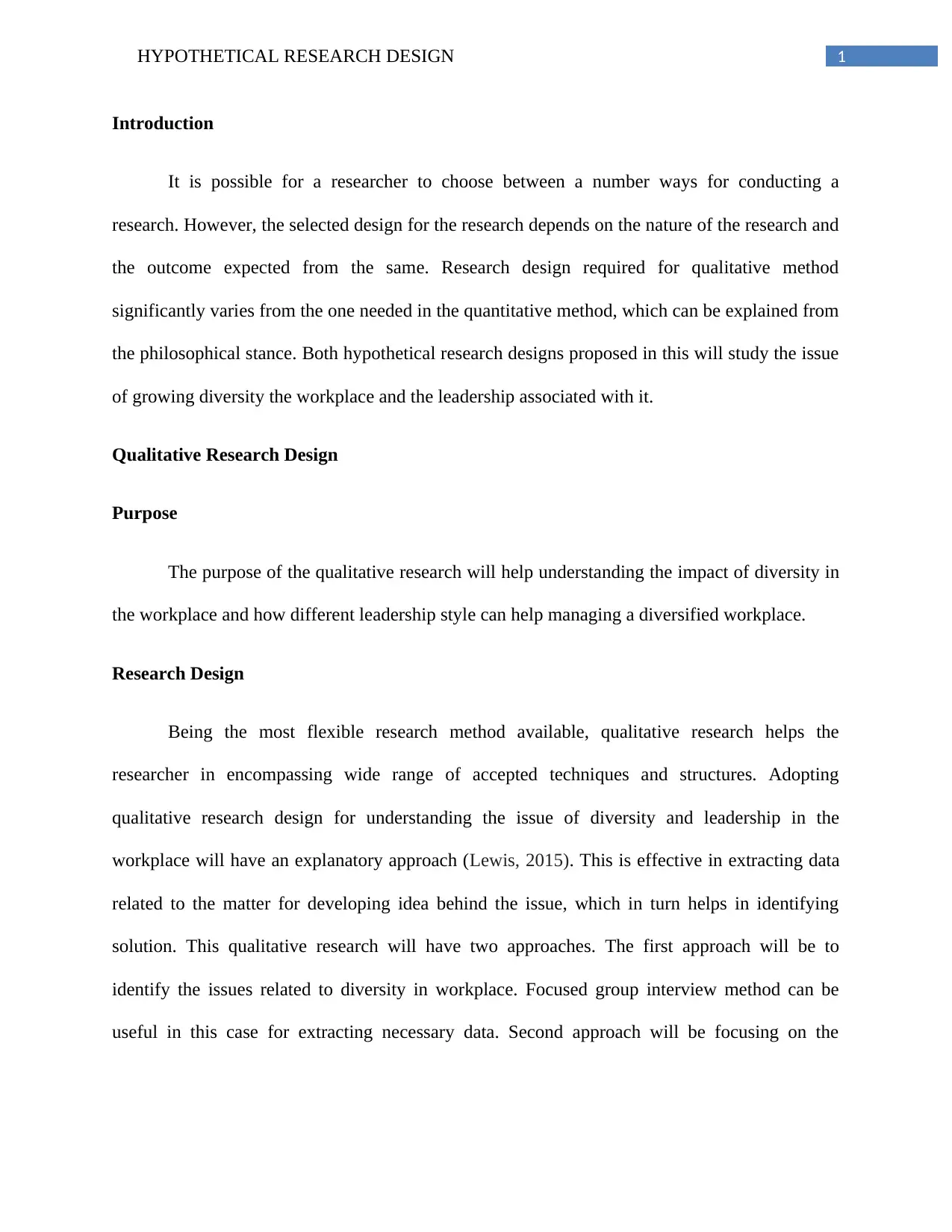
1HYPOTHETICAL RESEARCH DESIGN
Introduction
It is possible for a researcher to choose between a number ways for conducting a
research. However, the selected design for the research depends on the nature of the research and
the outcome expected from the same. Research design required for qualitative method
significantly varies from the one needed in the quantitative method, which can be explained from
the philosophical stance. Both hypothetical research designs proposed in this will study the issue
of growing diversity the workplace and the leadership associated with it.
Qualitative Research Design
Purpose
The purpose of the qualitative research will help understanding the impact of diversity in
the workplace and how different leadership style can help managing a diversified workplace.
Research Design
Being the most flexible research method available, qualitative research helps the
researcher in encompassing wide range of accepted techniques and structures. Adopting
qualitative research design for understanding the issue of diversity and leadership in the
workplace will have an explanatory approach (Lewis, 2015). This is effective in extracting data
related to the matter for developing idea behind the issue, which in turn helps in identifying
solution. This qualitative research will have two approaches. The first approach will be to
identify the issues related to diversity in workplace. Focused group interview method can be
useful in this case for extracting necessary data. Second approach will be focusing on the
Introduction
It is possible for a researcher to choose between a number ways for conducting a
research. However, the selected design for the research depends on the nature of the research and
the outcome expected from the same. Research design required for qualitative method
significantly varies from the one needed in the quantitative method, which can be explained from
the philosophical stance. Both hypothetical research designs proposed in this will study the issue
of growing diversity the workplace and the leadership associated with it.
Qualitative Research Design
Purpose
The purpose of the qualitative research will help understanding the impact of diversity in
the workplace and how different leadership style can help managing a diversified workplace.
Research Design
Being the most flexible research method available, qualitative research helps the
researcher in encompassing wide range of accepted techniques and structures. Adopting
qualitative research design for understanding the issue of diversity and leadership in the
workplace will have an explanatory approach (Lewis, 2015). This is effective in extracting data
related to the matter for developing idea behind the issue, which in turn helps in identifying
solution. This qualitative research will have two approaches. The first approach will be to
identify the issues related to diversity in workplace. Focused group interview method can be
useful in this case for extracting necessary data. Second approach will be focusing on the
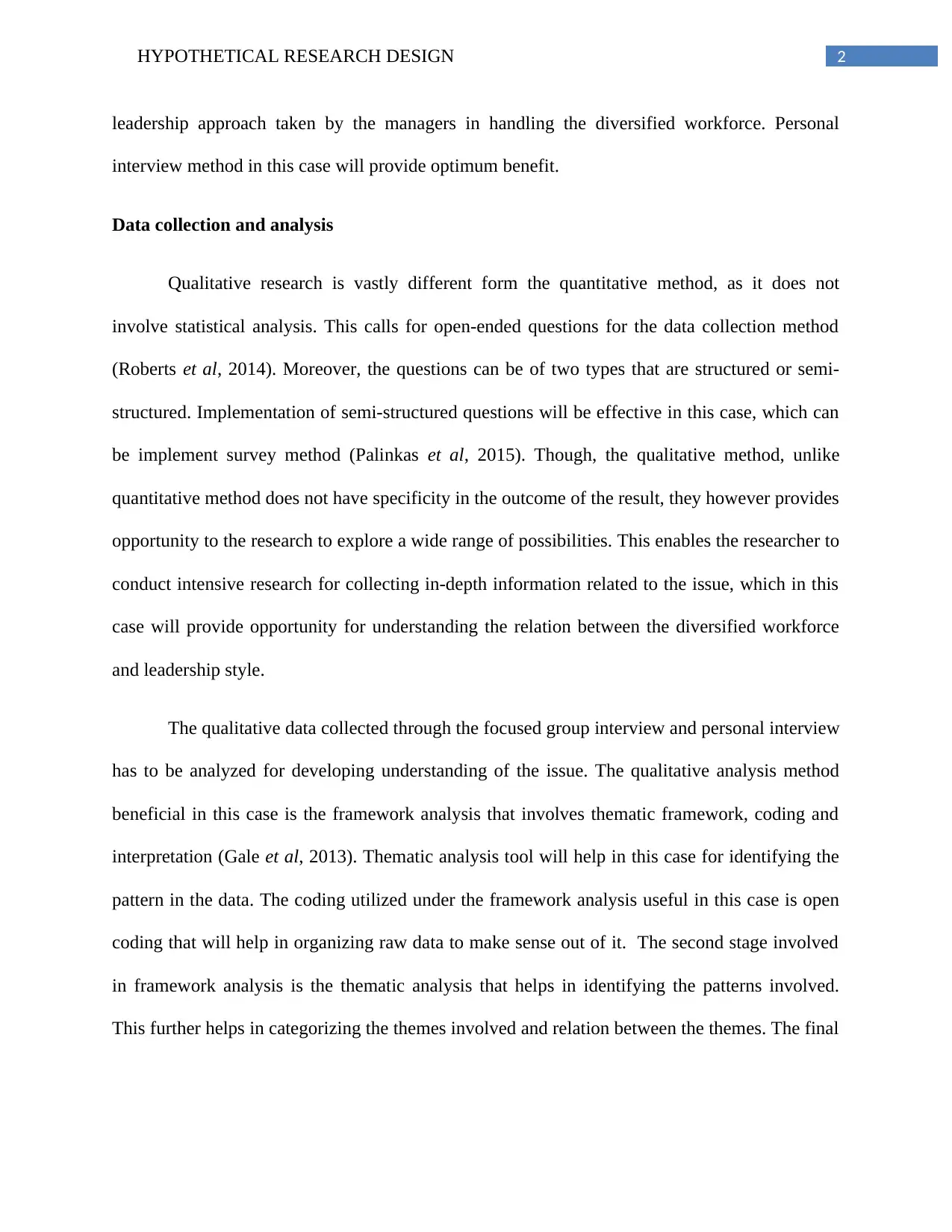
2HYPOTHETICAL RESEARCH DESIGN
leadership approach taken by the managers in handling the diversified workforce. Personal
interview method in this case will provide optimum benefit.
Data collection and analysis
Qualitative research is vastly different form the quantitative method, as it does not
involve statistical analysis. This calls for open-ended questions for the data collection method
(Roberts et al, 2014). Moreover, the questions can be of two types that are structured or semi-
structured. Implementation of semi-structured questions will be effective in this case, which can
be implement survey method (Palinkas et al, 2015). Though, the qualitative method, unlike
quantitative method does not have specificity in the outcome of the result, they however provides
opportunity to the research to explore a wide range of possibilities. This enables the researcher to
conduct intensive research for collecting in-depth information related to the issue, which in this
case will provide opportunity for understanding the relation between the diversified workforce
and leadership style.
The qualitative data collected through the focused group interview and personal interview
has to be analyzed for developing understanding of the issue. The qualitative analysis method
beneficial in this case is the framework analysis that involves thematic framework, coding and
interpretation (Gale et al, 2013). Thematic analysis tool will help in this case for identifying the
pattern in the data. The coding utilized under the framework analysis useful in this case is open
coding that will help in organizing raw data to make sense out of it. The second stage involved
in framework analysis is the thematic analysis that helps in identifying the patterns involved.
This further helps in categorizing the themes involved and relation between the themes. The final
leadership approach taken by the managers in handling the diversified workforce. Personal
interview method in this case will provide optimum benefit.
Data collection and analysis
Qualitative research is vastly different form the quantitative method, as it does not
involve statistical analysis. This calls for open-ended questions for the data collection method
(Roberts et al, 2014). Moreover, the questions can be of two types that are structured or semi-
structured. Implementation of semi-structured questions will be effective in this case, which can
be implement survey method (Palinkas et al, 2015). Though, the qualitative method, unlike
quantitative method does not have specificity in the outcome of the result, they however provides
opportunity to the research to explore a wide range of possibilities. This enables the researcher to
conduct intensive research for collecting in-depth information related to the issue, which in this
case will provide opportunity for understanding the relation between the diversified workforce
and leadership style.
The qualitative data collected through the focused group interview and personal interview
has to be analyzed for developing understanding of the issue. The qualitative analysis method
beneficial in this case is the framework analysis that involves thematic framework, coding and
interpretation (Gale et al, 2013). Thematic analysis tool will help in this case for identifying the
pattern in the data. The coding utilized under the framework analysis useful in this case is open
coding that will help in organizing raw data to make sense out of it. The second stage involved
in framework analysis is the thematic analysis that helps in identifying the patterns involved.
This further helps in categorizing the themes involved and relation between the themes. The final
⊘ This is a preview!⊘
Do you want full access?
Subscribe today to unlock all pages.

Trusted by 1+ million students worldwide
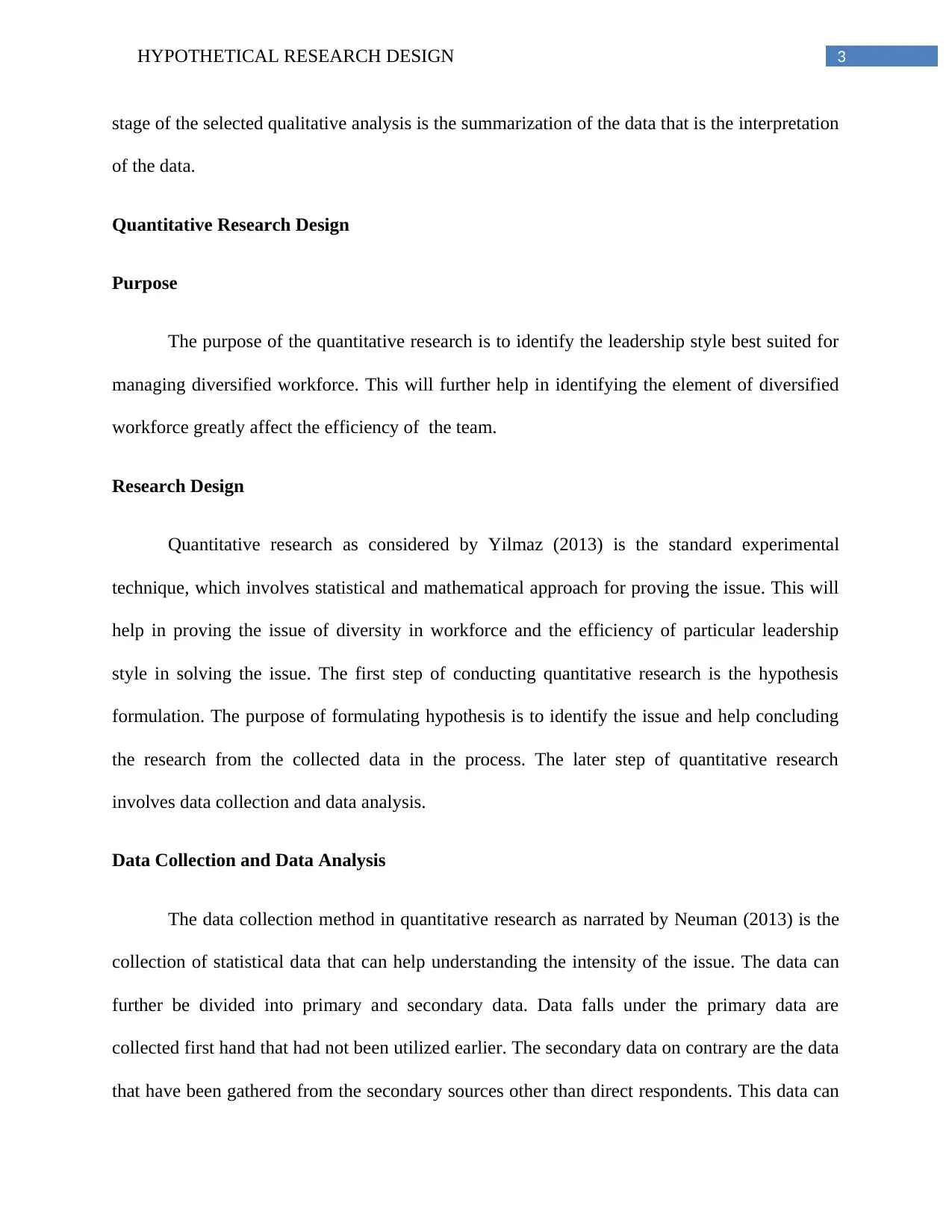
3HYPOTHETICAL RESEARCH DESIGN
stage of the selected qualitative analysis is the summarization of the data that is the interpretation
of the data.
Quantitative Research Design
Purpose
The purpose of the quantitative research is to identify the leadership style best suited for
managing diversified workforce. This will further help in identifying the element of diversified
workforce greatly affect the efficiency of the team.
Research Design
Quantitative research as considered by Yilmaz (2013) is the standard experimental
technique, which involves statistical and mathematical approach for proving the issue. This will
help in proving the issue of diversity in workforce and the efficiency of particular leadership
style in solving the issue. The first step of conducting quantitative research is the hypothesis
formulation. The purpose of formulating hypothesis is to identify the issue and help concluding
the research from the collected data in the process. The later step of quantitative research
involves data collection and data analysis.
Data Collection and Data Analysis
The data collection method in quantitative research as narrated by Neuman (2013) is the
collection of statistical data that can help understanding the intensity of the issue. The data can
further be divided into primary and secondary data. Data falls under the primary data are
collected first hand that had not been utilized earlier. The secondary data on contrary are the data
that have been gathered from the secondary sources other than direct respondents. This data can
stage of the selected qualitative analysis is the summarization of the data that is the interpretation
of the data.
Quantitative Research Design
Purpose
The purpose of the quantitative research is to identify the leadership style best suited for
managing diversified workforce. This will further help in identifying the element of diversified
workforce greatly affect the efficiency of the team.
Research Design
Quantitative research as considered by Yilmaz (2013) is the standard experimental
technique, which involves statistical and mathematical approach for proving the issue. This will
help in proving the issue of diversity in workforce and the efficiency of particular leadership
style in solving the issue. The first step of conducting quantitative research is the hypothesis
formulation. The purpose of formulating hypothesis is to identify the issue and help concluding
the research from the collected data in the process. The later step of quantitative research
involves data collection and data analysis.
Data Collection and Data Analysis
The data collection method in quantitative research as narrated by Neuman (2013) is the
collection of statistical data that can help understanding the intensity of the issue. The data can
further be divided into primary and secondary data. Data falls under the primary data are
collected first hand that had not been utilized earlier. The secondary data on contrary are the data
that have been gathered from the secondary sources other than direct respondents. This data can
Paraphrase This Document
Need a fresh take? Get an instant paraphrase of this document with our AI Paraphraser
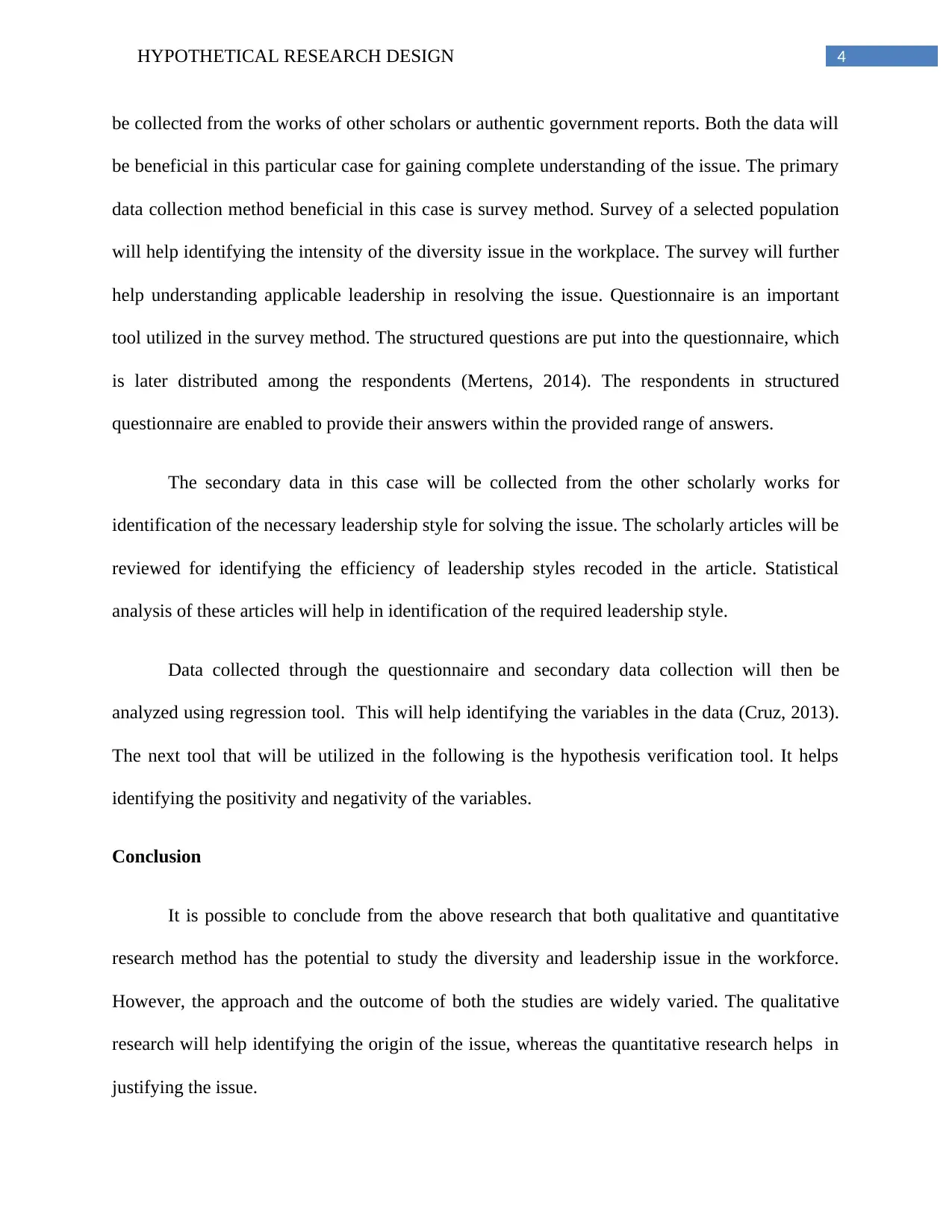
4HYPOTHETICAL RESEARCH DESIGN
be collected from the works of other scholars or authentic government reports. Both the data will
be beneficial in this particular case for gaining complete understanding of the issue. The primary
data collection method beneficial in this case is survey method. Survey of a selected population
will help identifying the intensity of the diversity issue in the workplace. The survey will further
help understanding applicable leadership in resolving the issue. Questionnaire is an important
tool utilized in the survey method. The structured questions are put into the questionnaire, which
is later distributed among the respondents (Mertens, 2014). The respondents in structured
questionnaire are enabled to provide their answers within the provided range of answers.
The secondary data in this case will be collected from the other scholarly works for
identification of the necessary leadership style for solving the issue. The scholarly articles will be
reviewed for identifying the efficiency of leadership styles recoded in the article. Statistical
analysis of these articles will help in identification of the required leadership style.
Data collected through the questionnaire and secondary data collection will then be
analyzed using regression tool. This will help identifying the variables in the data (Cruz, 2013).
The next tool that will be utilized in the following is the hypothesis verification tool. It helps
identifying the positivity and negativity of the variables.
Conclusion
It is possible to conclude from the above research that both qualitative and quantitative
research method has the potential to study the diversity and leadership issue in the workforce.
However, the approach and the outcome of both the studies are widely varied. The qualitative
research will help identifying the origin of the issue, whereas the quantitative research helps in
justifying the issue.
be collected from the works of other scholars or authentic government reports. Both the data will
be beneficial in this particular case for gaining complete understanding of the issue. The primary
data collection method beneficial in this case is survey method. Survey of a selected population
will help identifying the intensity of the diversity issue in the workplace. The survey will further
help understanding applicable leadership in resolving the issue. Questionnaire is an important
tool utilized in the survey method. The structured questions are put into the questionnaire, which
is later distributed among the respondents (Mertens, 2014). The respondents in structured
questionnaire are enabled to provide their answers within the provided range of answers.
The secondary data in this case will be collected from the other scholarly works for
identification of the necessary leadership style for solving the issue. The scholarly articles will be
reviewed for identifying the efficiency of leadership styles recoded in the article. Statistical
analysis of these articles will help in identification of the required leadership style.
Data collected through the questionnaire and secondary data collection will then be
analyzed using regression tool. This will help identifying the variables in the data (Cruz, 2013).
The next tool that will be utilized in the following is the hypothesis verification tool. It helps
identifying the positivity and negativity of the variables.
Conclusion
It is possible to conclude from the above research that both qualitative and quantitative
research method has the potential to study the diversity and leadership issue in the workforce.
However, the approach and the outcome of both the studies are widely varied. The qualitative
research will help identifying the origin of the issue, whereas the quantitative research helps in
justifying the issue.

5HYPOTHETICAL RESEARCH DESIGN
⊘ This is a preview!⊘
Do you want full access?
Subscribe today to unlock all pages.

Trusted by 1+ million students worldwide

6HYPOTHETICAL RESEARCH DESIGN
References
Cruz, C. D. (2013). Genes: a software package for analysis in experimental statistics and
quantitative genetics. Acta Scientiarum. Agronomy, 35(3), 271-276.
Gale, N. K., Heath, G., Cameron, E., Rashid, S., & Redwood, S. (2013). Using the framework
method for the analysis of qualitative data in multi-disciplinary health research. BMC
medical research methodology, 13(1), 117.
Lewis, S. (2015). Qualitative inquiry and research design: Choosing among five
approaches. Health promotion practice, 16(4), 473-475.
Mertens, D. M. (2014). Research and evaluation in education and psychology: Integrating
diversity with quantitative, qualitative, and mixed methods. Sage publications.
Neuman, W. L. (2013). Social research methods: Qualitative and quantitative approaches.
Pearson education.
Palinkas, L. A., Horwitz, S. M., Green, C. A., Wisdom, J. P., Duan, N., & Hoagwood, K. (2015).
Purposeful sampling for qualitative data collection and analysis in mixed method
implementation research. Administration and Policy in Mental Health and Mental Health
Services Research, 42(5), 533-544.
Roberts, M. E., Stewart, B. M., Tingley, D., Lucas, C., Leder‐Luis, J., Gadarian, S. K., ... &
Rand, D. G. (2014). Structural Topic Models for Open‐Ended Survey
Responses. American Journal of Political Science, 58(4), 1064-1082.
References
Cruz, C. D. (2013). Genes: a software package for analysis in experimental statistics and
quantitative genetics. Acta Scientiarum. Agronomy, 35(3), 271-276.
Gale, N. K., Heath, G., Cameron, E., Rashid, S., & Redwood, S. (2013). Using the framework
method for the analysis of qualitative data in multi-disciplinary health research. BMC
medical research methodology, 13(1), 117.
Lewis, S. (2015). Qualitative inquiry and research design: Choosing among five
approaches. Health promotion practice, 16(4), 473-475.
Mertens, D. M. (2014). Research and evaluation in education and psychology: Integrating
diversity with quantitative, qualitative, and mixed methods. Sage publications.
Neuman, W. L. (2013). Social research methods: Qualitative and quantitative approaches.
Pearson education.
Palinkas, L. A., Horwitz, S. M., Green, C. A., Wisdom, J. P., Duan, N., & Hoagwood, K. (2015).
Purposeful sampling for qualitative data collection and analysis in mixed method
implementation research. Administration and Policy in Mental Health and Mental Health
Services Research, 42(5), 533-544.
Roberts, M. E., Stewart, B. M., Tingley, D., Lucas, C., Leder‐Luis, J., Gadarian, S. K., ... &
Rand, D. G. (2014). Structural Topic Models for Open‐Ended Survey
Responses. American Journal of Political Science, 58(4), 1064-1082.
Paraphrase This Document
Need a fresh take? Get an instant paraphrase of this document with our AI Paraphraser
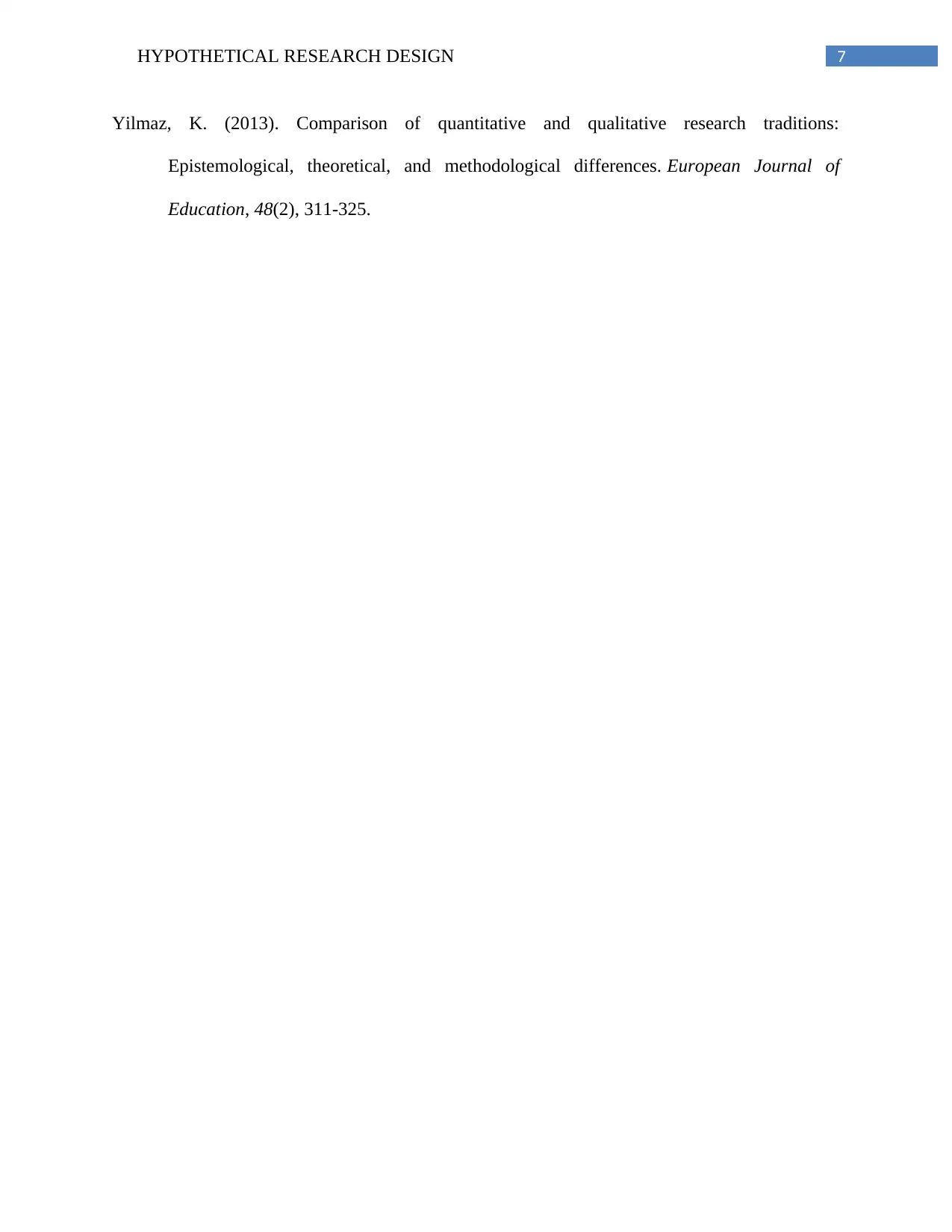
7HYPOTHETICAL RESEARCH DESIGN
Yilmaz, K. (2013). Comparison of quantitative and qualitative research traditions:
Epistemological, theoretical, and methodological differences. European Journal of
Education, 48(2), 311-325.
Yilmaz, K. (2013). Comparison of quantitative and qualitative research traditions:
Epistemological, theoretical, and methodological differences. European Journal of
Education, 48(2), 311-325.
1 out of 8
Related Documents
Your All-in-One AI-Powered Toolkit for Academic Success.
+13062052269
info@desklib.com
Available 24*7 on WhatsApp / Email
![[object Object]](/_next/static/media/star-bottom.7253800d.svg)
Unlock your academic potential
Copyright © 2020–2025 A2Z Services. All Rights Reserved. Developed and managed by ZUCOL.





